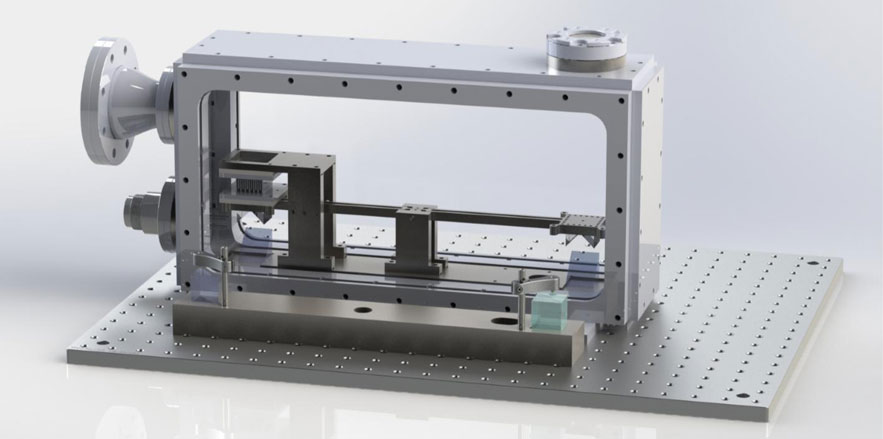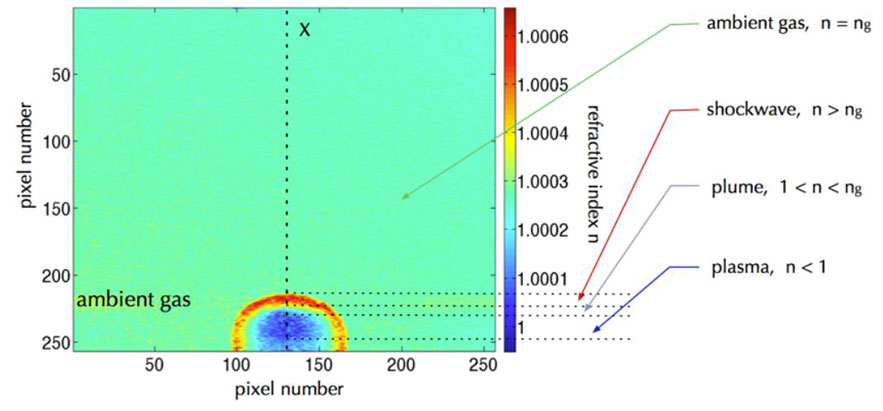A main objective of the programme is to develop and implement a novel integrated plasma diagnostics tool by combining nN force measurements with high speed pulsed digital holography, laser-induced fluorescence and volumetric ion current analysis within a thermal vacuum chamber. The proposed system will be used to increase our understanding of new and existing energy transfer mechanisms where plasmas are concerned e.g. studying phenomena in laser-matter interactions.
StudentSupervisor |
Advisor |
Background
The interaction of light and matter can produce a myriad of fascinating and useful phenomenon which are fundamental to many technologies and processes used today. As such, a wide range of laser technology has become available across a wide range of light intensities and interaction times to satisfy industrial and academic needs as shown in figure 1.
![Figure 1. Applications of lasers in materials processing [1]. Operations such as cutting, drilling and etching generally occur on timescales longer than microseconds at low to moderate intensities. Operations such as laser ablation, surface modification a](https://www.cdt-up.eng.cam.ac.uk/files/media/ng-figure-1.jpg)
Problem
The qualitative and quantitative results produced by light-matter interactions are determined by the properties of the source, material and mechanisms by which they interact. To achieve a desired result, there must be definition and control of as many parameters as possible so that optimisation can occur. Due to limitations in source technology combined spatial, temporal and polarisation pulse shaping has yet to be realised, and due to limitations in the understanding of interactions between light and matter, material specific responses have yet to be sufficiently characterised and thus applications must still be designed around the laser and empirically assessed for suitability, rather than the contrary [2]–[7]. This means that for each combination of laser and material, the correct parameter space, which includes many more parameters than just intensity and interaction time, must be found. Consequently, operating in this manner suggests many processes are inefficient with respect to energy consumption. If for example a pulsed laser with pulse energy of 100 µJ and repetition rate of 100 kHz operating on 8 hour days, 356 days a year, can be reduced to 90 µJ, the approximate energy saving would be 10.5 MJ. If this can then be translated to tens of thousands of lasers worldwide, the global energy saving becomes significant. These factors have stimulated research into wider and deeper characterisation of these interactions.
![Figure 2. An overview of mechanisms and their associated time scales within light-matter interactions induced by short pulses [8].](https://www.cdt-up.eng.cam.ac.uk/files/media/ng-figure-2.jpg)
Relevance
Laser technology has become an integral part of modern society, owing to the great number of operations lasers can perform, from surface modifications such as etching, welding and shock hardening to material removal operations such as drilling and ablation [8]. Each unique operation can be defined by a unique combination of interactions which vary with the parameters of the source and material being processed. Many fields depend on the understanding of these interactions as they form the basis for many technologies and processes including:
- Semi-conductor and super-conductor science: technologies utilising photolithography in manufacture or superconductivity in their function [4], [9].
- Medical science: tissue diagnosis capability, optical coherence tomography (OCT) or ablative modifications of tissue [7], [10].
- Material science: material analysis in analytical chemistry [11], [12].
- Energy research: fusion and diagnostic technologies [13], [14].
- Spacecraft propulsion: laser propulsion systems for moderate thrust and efficiency [15]–[18].
Solution
A novel, integrated diagnostics tool which combines:
- A pulsed, high-speed digital holographic camera for refractive index measurements:

- A nano-Newton torsion balance for impulse, mass-flow and specific impulse measurements:

- Electrostatic probes for current and magnetic field measurements.
- Laser spectroscopy for species measurements.
- Approach
A number of holographic interferograms are taken during an interaction (typically 2 - 16) and processed to provide the refractive index histories. The refractive index can then be used to calculate changes in temperature, pressure, density, velocity, and electron density and temperature and related to different regions of the interaction region such as the shockwave or plasma plume as shown in figure 5. The main advantage of this technique is the ability to simultaneously retrieve quantitative and qualitative data as both amplitude and phase information is available. Using a pulsed imaging laser, the camera is able to capture events occurring in the nanosecond regime and is therefore capable of capturing events occurring over very short timescales. The technique can also be used to provide 3D visualisation through tomographic reconstruction, which is useful as most light-matter interactions are inherently non-symmetrical.

The torsion balance is a novel additional to light-matter interaction studies, capable of measuring force (nN), impulse (nN.s) and mass loss (<µg), resulting in direct measurement of efficiency in terms of specific impulse (ISP). The balance allows for direct measurement of parameters which are are normally measured post-process or indrectly e.g mass loss and also adds new parameters to broad characterisation e.g impulsive force. The balance behaves in accordance with a second order massspring-damper system which can be solved to find the unknown impulse:

As the damping coefficient C and spring constant K can be measured from the deflection trace e.g. C from logarithmic decrement and K from the period, the unknown impulse can be calculated with low uncertainty as a function of the moment of inertia I, angular deflection x and distance r from the centre of rotation. The mass loss can then be calculated by looking at the change in balance equilibrium point between impulses.
Current Projects
The diagnostic suite being developed will lead to a deeper understanding of the energy and material transport mechanisms in a variety of laser materials operations and enable the development of a framework for designing energy efficient technologies and processes. These new toolsets, in addition to conventional inspection systems, will enable comprehensive materials process analysis. In the first instance, the platform will be used to support the following projects:
-
Thrust/efficiency optimised in-space laser propulsion systems.
-
Efficiency optimised laser-matter interactions for material processing using a laser with tuneable polar, spatial and temporal pulse profiles with Southampton Optoelectronics Research Group.
-
Efficiency optimised broadband RF generation using high energy ultra-short pulsed lasers with the Air Force Office of Scientific Research.
References
[1] D. Bäuerle, Laser Processing and Chemistry. Berlin, Heidelberg: Springer Berlin Heidelberg, 2011.
[2] M. S. Brown and C. B. Arnold, ‘Fundamentals of Laser-Material Interaction and Application to Multiscale Surface Modification’, in Laser Precision Microfabrication, vol. 135, K. Sugioka, M. Meunier, and A. Piqué, Eds. Berlin, Heidelberg: Springer Berlin Heidelberg, 2010, pp. 91–120.
[3] J. Han and Y. Li, ‘Interaction Between Pulsed Laser and Materials’, in Lasers - Applications in Science and Industry, K. Jakubczak, Ed. InTech, 2011.
[4] E. Fogarassy, S. Lazare, and Summer School on Laser Ablation of Electronic Materials, Eds., Laser ablation of electronic materials: basic mechanisms and applications. Amsterdam: North-Holland, 1992.
[5] Laser Material Processing | William Steen | Springer. .
[6] E. Kannatey-Asibu, Principles of Laser Materials Processing. Hoboken, NJ, USA: John Wiley & Sons, Inc., 2009.
[7] S. Svanberg, ‘Some Medical and Biological Applications of Ultrafast Lasers’, in Ultrafast Optics IV, vol. 95, F. Krausz, G. Korn, P. Corkum, and I. A. Walmsley, Eds. New York, NY: Springer New York, 2004, pp. 437–448.
[8] Krste Pangovski, ‘Temporal pulse design and analysis of silicon ablation using advanced pulse shaping and digital holography in the nanosecond domain’, PhD Thesis, University of Cambridge, 2014.
[9] J. Miller, Laser ablation and desorption. San Diego: Academic Press, 1998.
[10] A. Vogel and V. Venugopalan, ‘Mechanisms of Pulsed Laser Ablation of Biological Tissues’, Chem. Rev., vol. 103, no. 2, pp. 577–644, Feb. 2003.
[11] R. Russo, ‘Laser ablation in analytical chemistry—a review’, Talanta, vol. 57, no. 3, pp. 425–451, May 2002.
[12] G. Yang, ‘Laser ablation in liquids: Applications in the synthesis of nanocrystals’, Prog. Mater. Sci., vol. 52, no. 4, pp. 648–698, May 2007.
[13] R. S. Craxton et al., ‘Direct-drive inertial confinement fusion: A review’, Phys. Plasmas, Nov. 2015.
[14] K. Tanaka et al., ‘Study on behaviors of laser produced plumes for fusion material ablation’, 2011, pp. 1–1.
[15] C. Phipps et al., ‘A Review of Laser Ablation Propulsion’, 2010, pp. 710–722.
[16] M. Keidar et al., ‘Electric propulsion for small satellites’, Plasma Phys. Control. Fusion, vol. 57, no. 1, p. 014005, Jan. 2015.
[17] S. Sumida, H. Horisawa, and I. Funaki, ‘Experimental Investigation of μN-class Laser Ablation Thruster’, Trans. Jpn. Soc. Aeronaut. SPACE Sci. SPACE Technol. Jpn., vol. 7, no. ists26, p. Pb_159-Pb_162, 2009.
[18] H. Kuramoto, ‘Fundamental Study of a Forward Laser Plasma Accelerator for Space Propulsion Applications’, 2004, vol. 702, pp. 493–502.

